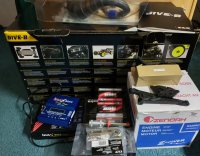This is octane business is not something you can ‘logic’ your way through, gasolines are made up of 100’s of hydrocarbons, empirical testing of its behaviour must be consulted, combustion kinetics is a beast of a subject, to the point for years there was not a commonly accepted theory to the exact mechanism of knock.
Initially there were two theories, the auto ignition theory, that the end gasses would auto ignite before being combusted by the main flame front, after decompasong to species more apt to combust.
The Detonation theory, that a true detonation/shockwave event would explode through the unburnt fuel charge in the combustion chamber when it pleased.
Then the excess flame speed theory, simply that the fuel burn rate/pressure rise was fast enough to induce knock symptoms, but that no auto ignition or detonation was taking place, I believe this was the third theory, interesting reading, but it was not correct, the generally accepted theory is now that the "end gas" products away from the flame front autoignite when the time/temperature situation they are placed under leads to compositional changes, free radicals and then autoignition.
Flame speed can play a part in octane rating, but it does not correlate across all tested fuels, it is true for some fuels a slower burn rate can reduce knock by limiting peak combustion temperatures, placing less thermal stress on end gasses, conversely slower combustion can induce knock, as the the slower flame front takes longer to reach and consume the end gasses at the periphery of the combustion chamber, leading to the time element of the time/temperature atack on end gas composition winning and initiating Knock, you can read about Hydrogen addition to speed up combustion, reducing knock, through the process of not allowing the end gasses time to autoignite.
You can be a stable fuel that doesn't devolve into the wrong 'species' in the end gasses.
You can burn fast enough to not allow the end gasses to overload.
You can burn slow enough to not thermally overload the end gasses, I question if this is something actually targeted for use in practice though?
Generally we see option 1, be stable under stress, as burn rate does not correlate well to octane rating.
And I know what you are thinking, latent heat of evaporation helps, yes, but propane also has a high octane rating, so it's not mandatory.
Octane rating is a measure of a fuels ability to withstand knock, period.
Fuels can have same auto ignition temp, but different octane rating, same vapour pressure, different octane rating, same flame speed different octane rating.
A quick google for some charts of in cylinder flame front speed measurement shows some interesting figures, they do note show flame speed correlates with octane rating.
Below iso-octane @ ron 100 Vs Ethanol @ ron 109
LINK to source
iso-octane on the left E100-Ethanol on the right.
View attachment 289499
Below another SI in cylinder combustion speed experiment.
LINK to source
View attachment 289505
Think they made a mistake, RON of Ethanol is closer to 109 than 129.
More data, though not from actual internal combustion engines, still relevant though, as combustion speed can be (VERY) roughly simplified as laminer burn speed plus turbulence.
From the 1986 NASA Technical Paper 2596
Velocity Profiles in Laminar Diffusion Flames
Note that Iso-octane and N-hepatne, the actual 100 and zero octane reference points of the RON test are within one percent of each others for laminar flame speed, with 100 octane points between them, other tests may have a larger difference, but this be NASA.
View attachment 289504
View attachment 289506
Think I got carried away.
TLDR
87 might burn faster than 91 pump and operate better in a chainsaw, but that does not mean higher octane = slower burning as a rule.








